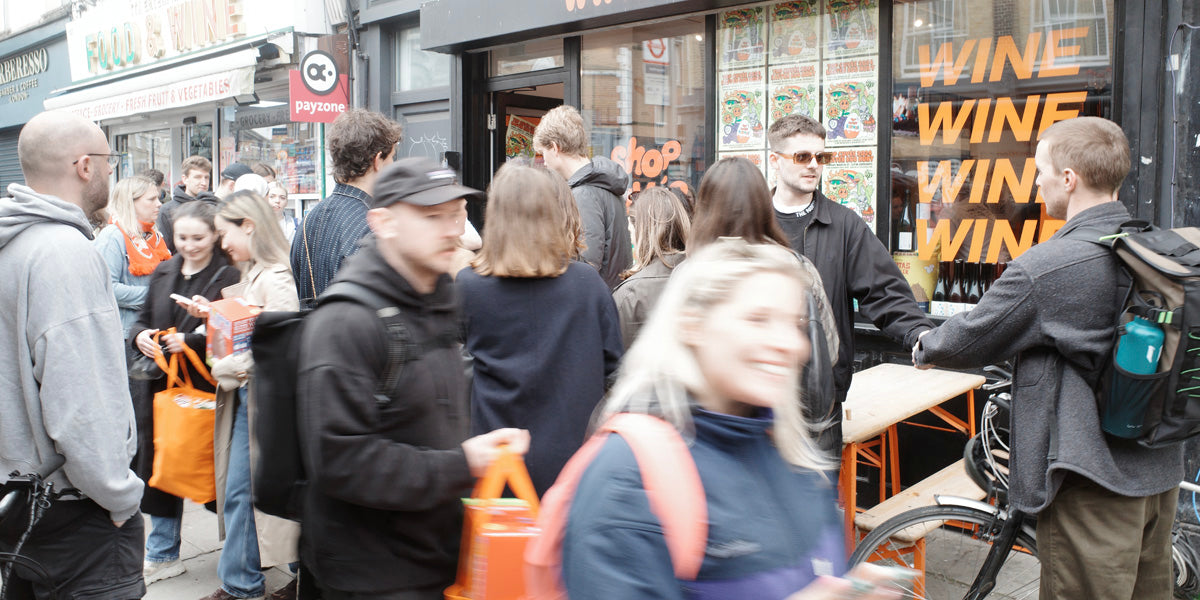
What Is Natural Wine?
Share
What Is Natural Wine?

Defining Natural Wine is not easy and for many, it is still considered a concept rather than a defined category. BUT, in 2019 along came the ‘Vin Methode Nature’ an accreditation in France which sets out a robust definition which we tend to agree with!
In order for a winemaker to qualify, they must:
- Grow their grapes organically and be recognised by one of the major certifying organisations. 🍇
- Yeasts necessary for fermentation must be ambient, found in the vineyard and/or winery, not added. 🍷
- No additions such as acid, sugar, tannin, water and colouring agents. ⛔️
- A maximum addition of 30 mg/L sulphur can be added at bottling 🧼
- Interventionist physical procedures are banned, such as reverse osmosis. 🚧
So simply put, Natural Wine is farmed organically 👩🌾 (either biodynamically, using permaculture or with the utmost respect for the land and ecosystem where the fruit is grown) and made without adding or removing anything in the cellar. 🧬 Either no additives or interventions are used or they are kept to a bare minimum. The wine is neither fined nor filtered and the result is a wine that is alive 🦠 and will evolve in the glass and over time in bottle.
Even simpler: Nothing added, nothing taken away! 💫

Common Natural Wine Terminology
Zero Zero
A wine that has had nothing added in the farming process (pesticides or herbicides) and nothing added or taken away in the cellar, including zero added sulphites.
Native Yeasts
Native, natural, wild, ambient or sauvage. These are all words used to describe the yeats that occur naturally either on the grapes, in the vineyard or the cellar of the wine being made. These yeasts begin the spontaneous fermentation of the wine and embody all things happening in the vineyard and the winery. Wines made with yeast additions are not natural wines.
Volatile Acidity (VA)
This is a tasting note used to describe wines that have an extreme or unpleasant level of acid. The wine tastes and smells like vinegar or nail polish. It is a complex term because a wine can have VA without being unpleasant, it can sometimes balance a wine or even blow off if left to sit for a time and settle. Some people enjoy VA, it can be a matter of taste and preference.
Organic Farming
Growing grapes without the use of pesticides or chemicals that are not derived naturally. It is not necessary for the fertilisers or other elements to be from the farm, as long as they are created using natural products. Farmers can become certified organic from several governing bodies.
Biodynamic Farming
Is a form of organic cultivation developed by the Austrian anthroposophist Rudolph Steiner in the 1920s. It is based on traditional practices, using poly-culture and animals at the heart of the farming process. Unlike organic farming, it is about prevention rather than treatment. Natural preparations are made to encourage microbial life, boost the immune system of plants and improve soil fertility. It is based on a concept that everything in the farm and the world is interconnected and has energy flowing through it, ‘the world is a living and receptive organism’. Biodynamics follows the Maria Thun (High-Priestess of biodynamics) calendar, and this signifies days upon which you can do certain jobs on the farm. There are 4 types of days: fruit, root, flower and leaf. Fruit for harvesting, root for pruning, flower days signify nothing must be done in the farm and leaf days are ideal days for watering. Although pretty much all biodynamic farms are dry grown. For example, you would not want to pick on a leaf day because this would correspond to the water element and thus your fruit would be rotten and waterlogged. Another common biodynamic practice is to fill cow horns with specially made compost then bury them in a pit in the ground. The horn is seen as a symbol of abundance. The horn is then dug up later in the year and the compost is then used to make tea to treat the vines.
In essence, it is a farming philosophy based on holistic, ecological and ethical beliefs, and whilst it may seem like pseudoscience, many farmers speak of how their crops now flourish because of it.
Dry Farming
Vines are not irrigated and rely only on rain. This is more environmentally responsible and is deemed to yield a more concentrated fruit flavour. Dry farming is practised at most if not all natural winemakers.
Mouse / Mousey
A hard one to explain, but more to be experienced. If you get a horrible taste, like a ‘farmy’, barn-yard, rodent-like taste or smell from wine, it is likely to be mousey. It is a fault that affects low-intervention wines due to the lack of additional sulfites to stabilise the wine, although the exact cause of mousiness is unknown. It is also said that certain people cannot detect mousiness. It can be an immediate trait within some wines, but more often than not will be due to wine that has been open too long.
Unfiltered Wine
Most conventional wines are filtered meaning that the winemaker will essentially save the wine to remove dead yeast cells or leftover organic matter from the grapes. Unfiltered wines are deemed to have more integrity and preserve the essence of how the wine was truly meant to be. Unfiltered wines are easy to spot due to the presence of sediment.
Unfined Wines
Unlike filtration which is used to remove excess particles from a wine, fining is used to remove soluble substances that can cloud the appearance of wine. To do this things like egg whites, blood and fish bladders are used to bind the substances and remove them.
Vegan Wine
Most wines are not vegan because they are fined, and can contain; casein (a milk protein), albumin (egg whites), gelatin (animal protein) or isinglass (fish bladder protein). Natural wines are more likely to be vegan because they are rarely fined. However, not all vegan wines are natural and not all natural wines are vegan.
Glou-Glou & Vin de Soif
Translated to ‘Glug-Glug’ & a term used to describe a wine for someone who is thirsty. These expressions are used to describe a certain style of natural wine, one that is carefree, easy-drinking and meant for drinking young.
Carbonic Maceration
A winemaking technique and form of whole bunch fermentation (popularised by its use in Beaujolais and created by Michael Flanzy) whereby whole bunches of grapes are placed into a vessel, which is then sealed and filled with CO2. This creates an anaerobic environment and the grapes begin to ferment from the inside out, eventually the grapes burst, the juices combine and the fermentation continues. This process is done to reduce bitter tannins and uncover more delicate fruit and floral flavours.
Semi-Carbonic Maceration
Essentially the same process as above, except this time no outside CO2 is used. Instead, the CO2 released is by the fermentation process at the bottom of the vat. The weight of the grapes above crushes the fruit below and catalyses the fermentation process. This process ceases when the alcohol level within the grapes reaches 2%, at this stage the grapes are pressed.
Brutal!
A cult label was designed and used to represent a wine that is zero-zero. No additions in the vineyard, no interventions in the winemaking process and zero added sulphites. The label is also used to show that the wine is an experiment.
Sediment
The bits floating around in the bottle or sitting at the base of the bottle. This is a mixture of dead yeast cells from the fermentation process and small bits of grape must.
Oxidative
A wine that has been deliberately exposed to oxygen in the winemaking process by not regularly topping up the barrels. This allows the wine to develop secondary flavours and aromas such as rich dried fruits, nuttiness and umami. Not to be confused with ‘oxidised’ notes which are when a wine has been exposed to too much oxygen post winemaking, this would lead to a flat and lifeless wine.
Reductive
Much the opposite of oxidative winemaking, reductive winemaking is when a winemaker takes steps to reduce the amount of contact that the wine has with oxygen. This is to maximise the fresh fruit flavours of a wine. Not to be confused with ‘reduced’ notes which are aromas created by volatile sulphur compounds.
TCA (Trichloroanisole)
This is a wine taint that gives off the aromas of damp cardboard. It’s hard to catch at low levels, but will also nullify fruit flavours in the wine. The main reason for TCA is tainted cork and for this reason wines with TCA are referred to as ‘corked’.
Brettanomyces (Brett)
This is a yeast that occurs in wines, giving off aromas of plastic, animals or barnyard. Some people enjoy this and say it is the true character of the wine, some people consider it to be a fault.
Malolactic Fermentation (MLF)
A winemaking process whereby tart malic acids are converted to softer, creamier lactic acid. This softens the wine and reduces acidity as well as creating buttery flavours and producing CO2.
Terroir
A French expression adopted by the wine world to express how a particular region’s climate, soils and topography (complete natural environment) affect the wine. Vignerons strive to create a wine that is expressive of the terroir and can connect the consumer to the specific place and time where the wine was grown.
Sulphites / SO2
Sulphites are a chemical compound that occur naturally in wine during fermentation, however, some winemakers will add sulphites artificially for their antioxidant and antibacterial properties. Natural winemakers will aim to add as little sulphites as possible (30mg/L is usually seen as the limit), but may have to at bottling to ensure the wines arrive safely.
Lees
Predominantly dead yeast cells left over from the fermentation process. ‘Gross lees’ refers to general sediment that forms in the wine after fermentation. ‘Fine lees’ are smaller particles that settle more slowly in the wine.
Permaculture
Agriculture development with the intent to be permanent, sustainable, and self-sufficient.
Viticulture
The science and study of farming grapes

